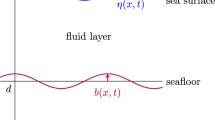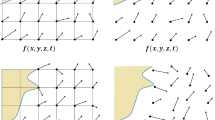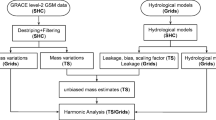Abstract
A method for generating computational meshes for applications in ocean modeling is presented. The method uses a standard engineering approach for describing the geometry of the domain that requires meshing. The underlying sphere is parametrized using stereographic coordinates. Then, coastlines are described with cubic splines drawn in the stereographic parametric space. The mesh generation algorithm builds the mesh in the parametric plane using available techniques. The method enables to import coastlines from different data sets and, consequently, to build meshes of domains with highly variable length scales. The results include meshes together with numerical simulations of various kinds.














Similar content being viewed by others
Notes
TIMOTHY, Tracing and Integrated Modeling of Natural and Anthropogenic Effects on Hydrosystems: The Scheldt River basin and adjacent coastal North Sea, http://www.climate.be/TIMOTHY.
SLIM, Second-generation Louvain-la-Neuve Ice-ocean Model, http://www.climate.be/SLIM
References
Arya S, Mount DM, Netanyahu NS, Silverman R, Wu AY (1998) An optimal algorithm for approximate nearest neighbor searching. J ACM 45:891–923. http://www.cs.umd.edu/ mount/ANN/
Beall MW, Shephard MS (1997) A general topology-based mesh data structure. Int J Numer Methods Eng 40(9):1573–1596
Danilov S, Kivman G, Schröter J (2005) Evaluation of an eddy-permitting finite-element ocean model in the north atlantic. Ocean Model 10:35–49
Dwyer RA (1986) A simple divide-and-conquer algorithm for computing delaunay triangulations in o(n log log n) expected time. In: Proceedings of the second annual symposium on computational geometry, Yorktown Heights, 2–4 June 1986, pp 276–284
George P-L, Frey P (2000) Mesh generation. Hermes, Lyon
Gorman G, Piggott M, Pain C (2007) Shoreline approximation for unstructured mesh generation. Comput Geosci 33:666–677
Gorman G, Piggott M, Pain C, de Oliveira R, Umpleby A, Goddard A (2006) Optimisation based bathymetry approximation through constrained unstructured mesh adaptivity. Ocean Model 12:436–452
Griffies SM, Böning C, Bryan FO, Chassignet EP, Gerdes R, Hasumi H, Hirst A, Treguier A-M, Webb D (2000) Developments in ocean climate modeling. Ocean Model 2:123–192
Hagen SC, Westerink JJ, Kolar RL, Horstmann O (2001) Two-dimensional, unstructured mesh generation for tidal models. Int J Numer Methods Fluids 35:669–686 (printed version in Richard’s office)
Haimes R (2000) CAPRI: computational analysis programming interface (a solid modeling based infra-structure for engineering analysis and design). Tech. rep., Massachusetts Institute of Technology
Henry RF, Walters RA (1993) Geometrically based, automatic generator for irregular triangular networks. Commun Numer Methods Eng 9:555–566
Lambrechts J, Hanert E, Deleersnijder E, Bernard P-E, Legat V, Wolanski J-FRE (2008) A high-resolution model of the whole great barrier reef hydrodynamics. Estuar Coast Shelf Sci 79(1):143–151. doi:10.1016/j.ecss.2008.03.016
Le Provost C, Genco ML, Lyard F (1994) Spectroscopy of the world ocean tides from a finite element hydrodynamic model. J Geophys Res 99:777–797
Legrand S, Deleersnijder E, Hanert E, Legat V, Wolanski E (2006) High-resolution, unstructured meshes for hydrodynamic models of the Great Barrier Reef, Australia. Estuar Coast Shelf Sci 68:36–46
Legrand S, Legat V, Deleersnijder E (2000) Delaunay mesh generation for an unstructured-grid ocean circulation model. Ocean Model 2:17–28
Lietaer O, Fichefet T, Legat V (2008) The effects of resolving the Canadian Arctic Archipelago in a finite element sea ice model. Ocean Model 24:140–152. doi:10.1016/j.ocemod.2008.06.002
Lyard F, Lefevre F, Letellier T, Francis O (2006) Modelling the global ocean tides: modern insights from FES2004. Ocean Dyn 56:394–415
National Geographic Data Center (2006) ETOPO1 global relief model. http://www.ngdc.noaa.gov/mgg/global/global.html.
Piggott M, Gorman G, Pain C (2007) Multi-scale ocean modelling with adaptive unstructured grids. CLIVAR Exch Ocean Model Dev Assess 12(42):21–23 (http://eprints.soton.ac.uk/47576/)
Rebay S (1993) Efficient unstructured mesh generation by means of delaunay triangulation and Bowyer-Watson algorithm. J Comput Phys 106:25–138
Weatherill NP (1990) The integrity of geometrical boundaries in the two-dimensional delaunay triangulation. Commun Appl Numer Methods 6(2):101–109
Wessel P, Smith WHF (1996) A global self-consistent, hierarchical, high-resolution shoreline database. J Geophys Res 101(B4):8741–8743. http://www.soest.hawaii.edu/wessel/gshhs/gshhs.html
White L, Deleersnijder E, Legat V (2008) A three-dimensional unstructured mesh finite element shallow-water model, with application to the flows around an island and in a wind-driven elongated basin. Ocean Model 22:26–47
Acknowledgements
The present study was carried out within the scope of the project A second-generation model of the ocean system, which is funded by the Communauté Française de Belgique, as Actions de Recherche Concertées, under contract ARC 04/09-316. This work is a contribution to the SLIMFootnote 2 project.
Author information
Authors and Affiliations
Corresponding author
Additional information
Responsible Editor: Pierre Lermusiaux
Rights and permissions
About this article
Cite this article
Lambrechts, J., Comblen, R., Legat, V. et al. Multiscale mesh generation on the sphere. Ocean Dynamics 58, 461–473 (2008). https://doi.org/10.1007/s10236-008-0148-3
Received:
Accepted:
Published:
Issue Date:
DOI: https://doi.org/10.1007/s10236-008-0148-3




